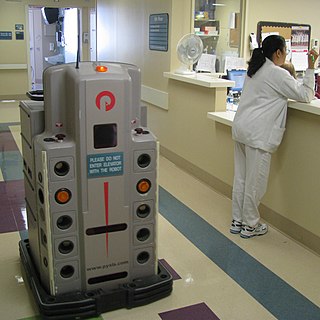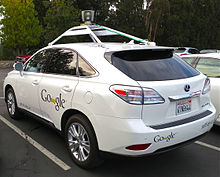
A robot is a machine—especially one programmable by a computer—capable of carrying out a complex series of actions automatically. A robot can be guided by an external control device, or the control may be embedded within. Robots may be constructed to evoke human form, but most robots are task-performing machines, designed with an emphasis on stark functionality, rather than expressive aesthetics.

Automation describes a wide range of technologies that reduce human intervention in processes, mainly by predetermining decision criteria, subprocess relationships, and related actions, as well as embodying those predeterminations in machines. Automation has been achieved by various means including mechanical, hydraulic, pneumatic, electrical, electronic devices, and computers, usually in combination. Complicated systems, such as modern factories, airplanes, and ships typically use combinations of all of these techniques. The benefit of automation includes labor savings, reducing waste, savings in electricity costs, savings in material costs, and improvements to quality, accuracy, and precision.

Home automation or domotics is building automation for a home. A home automation system will monitor and/or control home attributes such as lighting, climate, entertainment systems, and appliances. It may also include home security such as access control and alarm systems.

Rodney Allen Brooks is an Australian roboticist, Fellow of the Australian Academy of Science, author, and robotics entrepreneur, most known for popularizing the actionist approach to robotics. He was a Panasonic Professor of Robotics at the Massachusetts Institute of Technology and former director of the MIT Computer Science and Artificial Intelligence Laboratory. He is a founder and former Chief Technical Officer of iRobot and co-Founder, Chairman and Chief Technical Officer of Rethink Robotics and currently is the co-founder and Chief Technical Officer of Robust.AI.
Business process automation (BPA), also known as business automation,distinguished from Business Process Management (BPM), is the technology-enabled automation of business processes. It can help a business in simplicity, to increase digital transformation, increase service quality, improve service delivery, or contain costs. BPA consists of integrating applications, restructuring labor resources, and using software applications throughout the organization. Robotic process automation is an emerging field within BPA.

An agricultural robot is a robot deployed for agricultural purposes. The main area of application of robots in agriculture today is at the harvesting stage. Emerging applications of robots or drones in agriculture include weed control, cloud seeding, planting seeds, harvesting, environmental monitoring and soil analysis. According to Verified Market Research, the agricultural robots market is expected to reach $11.58 billion by 2025.
Amazon Robotics, formerly Kiva Systems, is a Massachusetts-based company that manufactures mobile robotic fulfillment systems. It is a subsidiary company of Amazon.com. Its automated storage and retrieval systems have been used in the past by companies including The Gap, Walgreens, Staples, Gilt Groupe, Office Depot, Crate & Barrel, and Saks 5th Avenue. Employees of erstwhile Kiva now only work in Amazon warehouses.

Technological unemployment is the loss of jobs caused by technological change. It is a key type of structural unemployment. Technological change typically includes the introduction of labour-saving "mechanical-muscle" machines or more efficient "mechanical-mind" processes (automation), and humans' role in these processes are minimized. Just as horses were gradually made obsolete as transport by the automobile and as labourer by the tractor, humans' jobs have also been affected throughout modern history. Historical examples include artisan weavers reduced to poverty after the introduction of mechanized looms. During World War II, Alan Turing's bombe machine compressed and decoded thousands of man-years worth of encrypted data in a matter of hours. A contemporary example of technological unemployment is the displacement of retail cashiers by self-service tills and cashierless stores.

CGP Grey is an Irish-American educational YouTuber, podcaster, live streamer, and former teacher based in the United Kingdom who creates explanatory videos on subjects including politics, geography, economics, sociology, history, philosophy, and culture. In addition to video production, he is known for creating and hosting the podcasts Hello Internet with Brady Haran and Cortex with Myke Hurley.

Zoltan Istvan Gyurko, professionally known as Zoltan Istvan, is an American transhumanist, journalist, entrepreneur, political candidate, and futurist.

Fintech, a portmanteau of "financial technology", refers to firms using new technology to compete with traditional financial methods in the delivery of financial services. Artificial intelligence, blockchain, cloud computing, and big data are regarded as the "ABCD" of fintech. The use of smartphones for mobile banking, investing, borrowing services, and cryptocurrency are examples of technologies designed to make financial services more accessible to the general public. Fintech companies consist of both startups and established financial institutions and technology companies trying to replace or enhance the usage of financial services provided by existing financial companies.

Martin Ford is an American futurist and author focusing on artificial intelligence and robotics, and the impact of these technologies on the job market, economy and society.

Clearpath Robotics, Inc. was founded in 2009 by a group of four University of Waterloo graduates, and remains headquartered in Waterloo Region, Canada. The original goal of Clearpath was to streamline field robotics research for universities and private corporations, but the company has since expanded and is now also manufacturing and selling the OTTO line of self-driving vehicles for industrial environments.

UiPath is a global software company that makes robotic process automation (RPA) software. It was founded in Bucharest, Romania, by Daniel Dines and Marius Tîrcă. Its headquarters are in New York City. The company's software monitors user activity to automate repetitive front and back office tasks, including those performed using other business software such as customer relationship management or enterprise resource planning (ERP) software.

Steven Wolfe, better known as Johnny Sins, is an American pornographic actor, director, and YouTuber. He is consistently among the most popular male talent pornography searches and is known for his shaved head, muscular physique, and blue eyes. He has received many accolades for his work, including three AVN Awards for Male Performer of the Year nominations as well as multiple nominations. He has also been the subject of many memes, most of which center on the large variety of occupations his pornographic characters have worked.

Polanyi's paradox, named in honour of the British-Hungarian philosopher Michael Polanyi, is the theory that human knowledge of how the world functions and of our own capability are, to a large extent, beyond our explicit understanding. The theory was articulated by Michael Polanyi in his book The Tacit Dimension in 1966, and economist David Autor gave it a name in his 2014 research paper "Polanyi's Paradox and the Shape of Employment Growth".
In futurology, political science, and science fiction, a post-work society is a society in which the nature of work has been radically transformed.

The War on Normal People: The Truth About America's Disappearing Jobs and Why Universal Basic Income Is Our Future is a 2018 book written by Andrew Yang, an American entrepreneur and Venture for America founder, who would later run as a 2020 Democratic presidential candidate on policy strategies discussed in the book. It was published by Hachette Books in the United States on April 3, 2018. A paperback edition was released on April 2, 2019. Yang narrated an audiobook version released on YouTube in September 2018.

Jason Kingdon is a computer scientist and entrepreneur. He was previously CEO of Blue Prism and co-founder of several AI companies. He was co-founder of UCL's Intelligent Systems Lab where he introduced the use of a neural network in live financial forecasting, and co-founder and CEO of Searchspace, a company that applied AI to detect money laundering and detect insider dealing at banks and stock exchanges. In 2008, he joined Blue Prism as executive chairman. The company has been credited with creating the Robotic Process Automation market.
Artificial intelligence (AI) in hiring involves the use of technology to automate aspects of the hiring process. Advances in artificial intelligence, such as the advent of machine learning and the growth of big data, enable AI to be utilized to recruit, screen, and predict the success of applicants. Proponents of artificial intelligence in hiring claim it reduces bias, assists with finding qualified candidates, and frees up human resource workers' time for other tasks, while opponents worry that AI perpetuates inequalities in the workplace and will eliminate jobs. Despite the potential benefits, the ethical implications of AI in hiring remain a subject of debate, with concerns about algorithmic transparency, accountability, and the need for ongoing oversight to ensure fair and unbiased decision-making throughout the recruitment process.
















